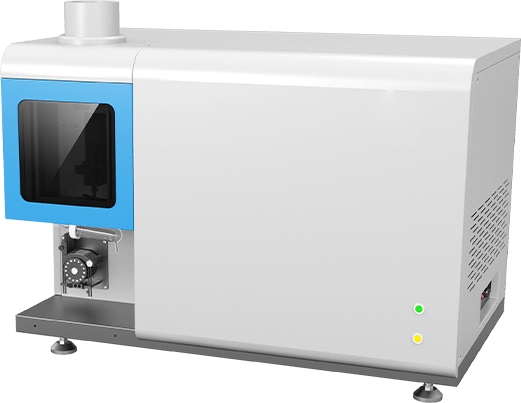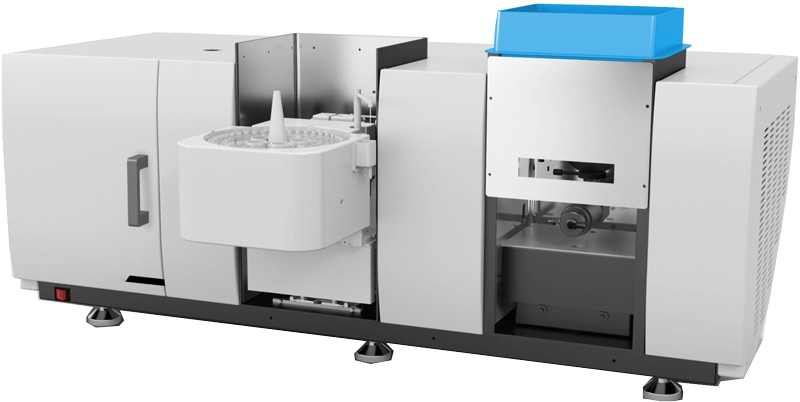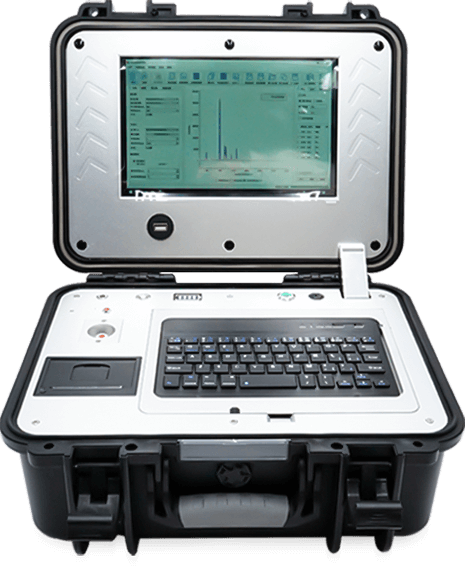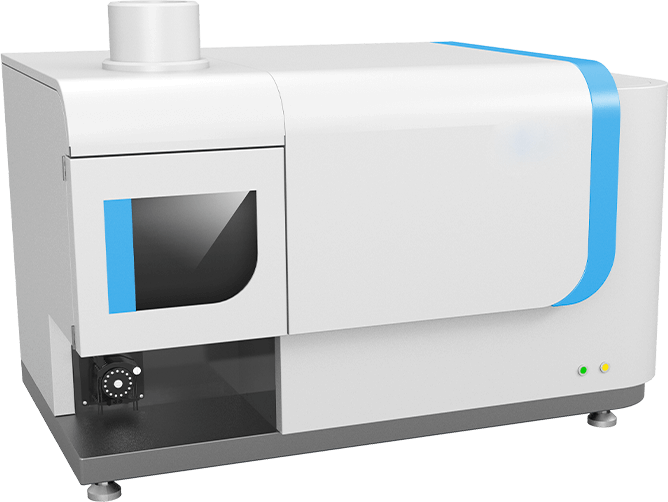
Atomic Emission Spectrometer
- Product Number:LD-ICP2
- Product Difference:50 elements/min, for inorganic elemental analysis, determining the content of major, minor, and trace elements in various substances
Product Introduction
LD-ICP2 Full-Spectrum Direct-Reading Inductively Coupled Plasma Emission Spectrometer is a new-generation ICP-OES product launched by Shandong Lainder based on years of experience in developing spectroscopic instruments.
This atomic emission spectrometer employs a reliable integrated solid-state RF power supply, a robust temperature-controlled two-dimensional dispersion system, and a research-grade refrigerated anti-spill CCD detection system. Combined with spectral correction technology, it delivers exceptional operability, flexibility, and reliability beyond expectations. Its daily operation and maintenance are remarkably simple, making it ideally suited for laboratory requirements. It achieves miniaturization, convenience, (Intelligentize), and convenience (Convenience).
Atomic emission spectrometers are currently the mainstream products for inorganic element analysis. They offer advantages such as minimal spectral interference, excellent stability, and rapid analysis, making them a commonly used method in the field of inorganic element analysis.
Atomic emission spectrometers find extensive applications across environmental protection, food safety, geology and mining, metallurgy, non-ferrous metals, rare earths, chemical engineering, clinical medicine, petroleum products, semiconductors, and agricultural research. They determine major, minor, and trace element concentrations in various materials, enabling qualitative, semi-quantitative, and precise quantitative analysis of elements in samples with detection limits reaching parts per billion (ppb) levels.
Product Features
Safe and Reliable Solid-State RF Power Supply
The instrument employs an RF power supply characterized by compact size, high output efficiency, and stable power delivery. Equipped with comprehensive safety protections including water circuit, gas circuit, and overload safeguards, it significantly enhances operational safety and reduces failure rates.Precision Spectral System
Utilizing a medium-resolution grating combined with prism cross-dispersion spectroscopy, the precision optical design achieves maximum light throughput and exceptional spectral resolution. The absence of any moving optical components ensures excellent repeatability and long-term stability.High Automation Level
The instrument features high automation, with all operations except power switching performed by software. Intelligent software provides real-time feedback and prompts for each operation.Intelligent flame monitoring
Equipped with a highly sensitive fiber optic sensor, the instrument continuously monitors flame status during operation. In case of abnormal flame extinction, it automatically shuts down the system.Fully Automated Ignition and Matching Technology
The software enables one-click automatic ignition, with all parameter adjustments performed automatically. Combined with advanced automatic matching technology, it achieves high ignition success rates and simplified operation.Research-Grade Large-Format CCD Detector
Features a proprietary CCD detection system with megapixel resolution; covering the entire 160-900nm wavelength range. All elements are detected simultaneously with a single exposure.Separate Sample Introduction System
The split design of atomization chamber and torch tube minimizes the impact of combustion chamber temperature fluctuations on atomization efficiency, enabling more intuitive observation of real-time sample introduction status. Combined with an extended atomization chamber, it effectively separates gas and liquid phases, reducing interference from water vapor.High-Precision Gas Flow Control System
All plasma gas, auxiliary gas, and carrier gas during operation are controlled by high-precision mass flow controllers (MFCs). These offer continuously adjustable flow rates and high output precision, ensuring accurate test data.Unprecedented Testing Speed
Achieve a test cycle in 20 seconds by configuring optimal integration times. Readout all analyzed spectral line intensities in a single exposure. Accurately measure nearly 70 elements per sample within one minute.Convenient Wavelength Calibration
Intelligent automatic wavelength calibration algorithm enables software-driven calibration upon startup, significantly reducing calibration time and costs.Interference Reduction Design
Ultra-low stray light components combined with optimized optical design substantially minimize background light interference, further lowering the instrument's detection limits.Peristaltic Pump Sampling System
The peristaltic pump features a 15-rotor, 5-channel fully automated design. Pump speed can be adjusted according to required flow rates, meeting special application needs such as online sample dilution and online internal standard addition.One-Second Torch Positioning
Utilizing a torch auxiliary installation tool ensures precise concentric alignment between the torch and coil, guaranteeing zero positional deviation and stable test signals.
Product parameters
| Sample introduction system | Extended-length fog chamber | Effectively reduces background noise while maintaining high sensitivity, with low memory effect |
| Atomizer | Effective concentric atomizer with high atomization efficiency, excellent repeatability, and minimal memory effect, enabling direct self-priming sample introduction | |
| Burner Tube | Quick-release burner tube paired with proprietary burner tube fixture enables one-second precise positioning, minimizing positional errors during tube replacement that could affect test performance | |
| Peristaltic Pump | Features a 5-channel, 16-roller fully automatic design with continuously adjustable pump speed. Ensures stable sample injection while supporting simultaneous operation of sample injection, waste discharge, online internal standard injection, and other reagent injection lines (e.g., hydride generator) | |
| Split-chamber injection system | Separates the torch tube and nebulizer chamber to minimize high-temperature interference from the torch tube on nebulization. Enables direct observation of sample flow for real-time anomaly detection | |
| Integrated gas pathway | Fully automated control utilizing precision mass flow controllers to regulate multiple gas streams with accuracy of 0.01 L/min | |
| Low Gas Protection Function | The instrument automatically extinguishes the flame when the gas supply is depleted and emits a real-time audible alarm via a buzzer | |
| Flame Video Monitoring | Equipped with a high-sensitivity flame sensing system and a visual video monitoring camera, the instrument enables real-time observation of the combustion chamber flame status. It automatically shuts off the RF power supply upon flame loss to protect critical components | |
| Monitoring Module | The visual instrument operation monitoring module tracks the operational status of all components, identifies fault causes, and facilitates the normal functioning of each part | |
| Versatility | Multiple atomizer, vaporization chamber, and torch tube options available to accommodate organic, high-salt, high-sensitivity, and HF acid-resistant sample requirements. Easy replacement and maintenance | |
| Plasma System | Plasma Observation Method | Vertical Rectangular Tube |
| Fully Digital-Controlled RF Power Supply | Power Range: 500-1600W, continuously adjustable in 1W increments; Power Stability ≤0.01% | |
| Self-oscillating, fully solid-state RF generator | Rapid impedance matching, automatic tuning, water-cooled heat dissipation | |
| Intelligent attenuation | Features automatic attenuation capability, capable of attenuating samples with concentrations up to 100 times, simplifying analysis. Enables analysis of samples with high elemental content and wide concentration gradients without manual dilution | |
| Frequency | Greater than 27.12MHz, frequency stability ≤0.01% | |
| Optical System | Spectral Components | Features next-generation medium-resolution gratings and prisms as spectral components, with no internal moving parts for excellent optical stability |
| Thermostatically Controlled Optical System | All optical components are sealed within a thermostatically controlled optical chamber, featuring an isolated design from the main unit. The chamber maintains precise temperature control at 36°C ±0.1°C with argon gas purging | |
| Optical Path Focal Length | 40mm, total internal reflection imaging path, quartz prism two-dimensional dispersion system | |
| Optical System Wavelength Range | 165-900nm, full wavelength coverage | |
| Wavelength Calibration | At each ignition, the software automatically calibrates spectral peak positions using air element lines (C, N, Ar, etc.), ensuring analytical wavelength accuracy without requiring calibration solutions | |
| Purge-Type Optical Chamber | For measurements below 189nm, argon or nitrogen gas can be selected for optical path purging | |
| Stray light | ≤2.0 mg/L (measured at 188.980 nm in a 10,000 mg/L Ca solution) | |
| Optical Resolution | ≤0.007nm (at 200nm) | |
| Detection System | Solid-State Detector | Effective semiconductor-cooled CCD solid-state detector with continuous pixels across the spectrometer's wavelength range, enabling arbitrary wavelength selection |
| Semiconductor Cooling | Features effective semiconductor cooling (three-stage TEC) with a cooling temperature down to -45°C and a startup time < 3 minutes | |
| Anti-saturation overflow protection | Back-drain overflow protection designed for each pixel, completely eliminating spectral line saturation overflow issues | |
| Intelligent Integration Design | Simultaneous acquisition of signal and background, capturing both high-intensity and weak signals at optimal signal-to-noise ratio. Expanded dynamic range enables simultaneous detection of high- and low-abundance elements | |
| Detection Unit | Detector surface free of any photo-conversion chemical coating, eliminating detector damage or replacement due to coating degradation. Detection unit resolution no less than one million pixels. | |
| Software | Graphical user interface with intuitive, user-friendly operation, featuring qualitative, semi-quantitative, and quantitative analysis capabilities | |
| Includes a spectral line library with over 75,000 entries, each allowing measurement at a minimum of 30 selectable pixels. Features an open software database | ||
| Features full spectrum acquisition capability, enabling direct retrieval of complete spectral maps within the software to assess sample spectra and spectral interference conditions | ||
| Features multiple interference correction methods and real-time background subtraction functions, such as external standard method, internal standard method, interference element correction coefficient method (IEC), standard addition method, and various data analysis and verification techniques | ||
| Includes a visual instrument operation status monitoring module | ||
| Equipped with a full-color real-time plasma imaging system, enabling software monitoring of plasma flame conditions | ||
| Software supports optional configuration of audit trail functionality, enabling multi-user, multi-level permission settings with comprehensive operation log recording. Test results can be automatically uploaded to designated computers within the local area network, significantly enhancing work efficiency | ||
| Performance Metrics | Analysis Speed | ≥50 elements or spectral lines per minute, with ≥10 seconds integration time per measured spectral line |
| Sample Consumption | <2 ml, capable of measuring no fewer than 70 elements | |
| Spectral Flexibility | Enables qualitative, semi-quantitative, and quantitative analysis of target elements | |
| Linear Dynamic Range | ≥10⁶ | |
| Internal Standard Calibration | Internal standard calibration function enables simultaneous exposure of internal standard elements and measured elements | |
| Precision | When measuring 1ppm or 10ppm multi-element mixed standard solutions, RSD ≤ 0.5% after ten repeated measurements | |
| Stability | Long-term stability RSD < 1.0% for 1ppm or 10ppm multi-element mixed standard solutions | |
| Detection Limit | Typical detection limits as low as 0.1 μg/L for elements | |

 +86 19353291814
+86 19353291814
 +86 19353291814
+86 19353291814


